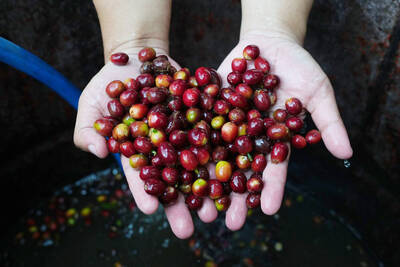France’s hunger for frogs’ legs is “destructive to nature” and endangering amphibians in Asia and south-east Europe, a group of scientists and vets have warned.
More than 500 experts from research, veterinary and conservation groups have called on Emmanuel Macron, the French president, to “end the overexploitation of frogs” and afford the most traded species better protections.
GLOBAL TRADE

Photo: EPA
The EU imports the equivalent of 80-200 million frogs each year, the majority of which are consumed in France. Most come from wild populations in Indonesia, Turkey and Albania, as well as from farms in Vietnam, according to a study by Robin des Bois and Pro Wildlife, two conservation nonprofits that organized the letter.
The practice is “not at all in line” with the EU’s wildlife strategy, said Sandra Altherr, the head of science at Pro Wildlife. “It’s absurd: the natural frog populations here in Europe are protected under EU law. But the EU still tolerates the collection of millions of animals in other countries — even if this threatens the frog populations there.”
More frogs’ legs are eaten in France — often fried in batter or sauted with garlic and parsley — than in any other country in the EU. The scientists argue that France should push to secure global protections for vulnerable frog species under the Convention on International Trade in Endangered Species of Wild Fauna and Flora (CITES), which works to stop the illegal trade in plants and animals.

Photo: Reuters
A group of 46 environment NGOs made a similar request of the French environment ministry in February.
ENDANGERED SPECIES
Studies suggest that some frog species are already suffering. The fanged river frog (Limnonectes macrodon) has apparently disappeared from commercial imports to France, according to the letter to Macron, while two more common species — the crab-eating frog (Fejervarya cancrivora) and rice-field frog (Fejervarya limnocharis) — have been in decline due to intense commercial harvests for many years.
Frogs also play important roles in ecosystems and on farms. Tadpoles can improve water quality in ponds and frogs can help farmers use fewer pesticides. They could also help keep infectious disease at bay by eating mosquitoes.
Alain Moussu, the president of the Veterinaires pour la Biodiversite, a third group that organized the letter, said veterinarians have joined the initiative in large numbers. “They are both sensitive to the cruelty that prevails in this market and concerned about the ecological imbalances caused by the collapse of amphibian populations,” he said.

Climate change, political headwinds and diverging market dynamics around the world have pushed coffee prices to fresh records, jacking up the cost of your everyday brew or a barista’s signature macchiato. While the current hot streak may calm down in the coming months, experts and industry insiders expect volatility will remain the watchword, giving little visibility for producers — two-thirds of whom farm parcels of less than one hectare. METEORIC RISE The price of arabica beans listed in New York surged by 90 percent last year, smashing on Dec. 10 a record dating from 1977 — US$3.48 per pound. Robusta prices have

A few years ago, getting a visa to visit China was a “ball ache,” says Kate Murray. The Australian was going for a four-day trade show, but the visa required a formal invitation from the organizers and what felt like “a thousand forms.” “They wanted so many details about your life and personal life,” she tells the Guardian. “The paperwork was bonkers.” But were she to go back again now, Murray could just jump on the plane. Australians are among citizens of almost 40 countries for which China now waives visas for business, tourism or family visits for up to four weeks. It’s